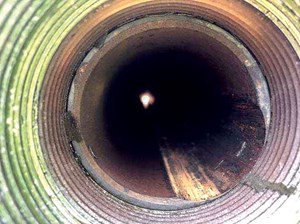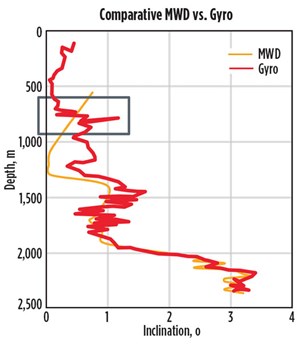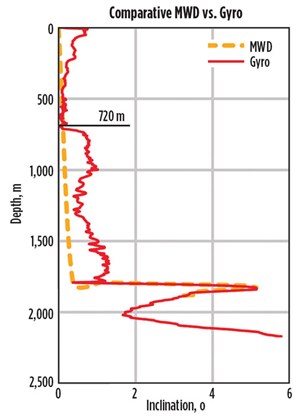Optimizing artificial lift placement in highly deviated wells using analysis of high-density tortuosity and bend data
Volatility in commodity markets has always been a driver for technological innovation, especially in the oil and gas industry. After declining market conditions demanded that the industry reassess how it drilled wells, operators began implementing all manner of equipment and systems designed to reduce the overall time to get to TD, and begin the completions phase of the project.
Success in this endeavor led to dramatic improvements in drilling times that fundamentally changed how the industry looked at drilling economics. This was a double-edge sword, however, as many wells had not taken the quality of the wellbore, itself, into account, leading to all manner of problems when completion and production were initiated. At this point, operators began to look more seriously at wellbore quality as a critical component of any well plan. This drove an interest in new technology that would address the issues inherent in low-quality wellbores, particularly tortuosity.
THE NEED FOR HIGH-DENSITY SURVEY DATA
Advancements in technology and upgrades to MWD systems are allowing surveys to be taken in a dynamic environment while drilling, but though these surveys provide insight into the real-time wellbore trajectory, they are typically not as accurate as traditional downhole survey measurements taken at stand-length intervals. Problematically, these large intervals between surveys effectively create a knowledge gap between the perceived and actual wellbore path, especially in aging wells with insufficient or poor-quality data. During operations where the achieved build rate is too high, the TVD at the end of a drilled section may exceed the planned depth. The inverse is also true. As the industry recognized the growing need for greater wellbore quality, it was clear that a new solution with higher-density, continuous data was necessary to overcome the prevalence of tortuousity in drilled wellbores.
Wellbore tortuosity has a significant impact with regard to the design and installation of completions and production equipment. The well path, and tortuosity, are commonly determined from data based on MWD technology and stationary directional surveys at 30-m intervals. Specifically, the inaccurate representation of well trajectory means that side forces calculated by using the discrete directional data will be inaccurate, making the determination of optimal placement for artificial lift systems impossible. Complex well geometry and low data density complicate the issue, leading to a higher failure rate in production equipment, associated downtime, reduced run life, and lost production. By increasing the density of the data and taking surveys continuously, these issues can be mitigated. High-density survey data are relevant to individual sections of the well, or the well in its entirety, and can be obtained in cased-hole applications to achieve efficiency and cost-related benefits.
Gyrodata introduced a novel tortuosity log called MicroGuide to offer the market a means of obtaining and analyzing high-density wellbore tortuosity data. The system looks at tortuosity from survey stations on the wellbore log via gyroscopic tools, magnetic instruments, or a combination thereof. The system defines reference lines for the wellbore path and displacements from that path, based on the received data, allowing 3D visualization of the wellbore. The use of the high-density, high-resolution data from the system’s 0.3-m log intervals provides insight into accurate wellbore geometry, which would often go undetermined when using data from other survey types. Benefits of running the high-density tortuosity logging system can be broadly summarized as follows:
- Determining if the casing was set in tension or compression
- Reducing uncertainty around TVD and lateral measurements
- Improving BHA design to account for torque and drag in individual wellbores
- Identifying optimal placement for production equipment, including electrical submersible pumps (ESPs) and sucker rod pumps (SRPs).
A case history from the highly deviated wells of Aguada Toledo field in Argentina is presented here. In this project, operator YPF determined that the region’s complex well geometry, combined with the low data density and uncertainty as to wellbore trajectory resulting from other survey methods, was cause to implement a new technology to optimize their artificial lift systems. With innovation as a core pillar of how YPF operates, and a history of operational and technical excellence, this project presented an opportunity to prove the viability of Gyrodata’s wellbore tortuosity logging system for future implementation, when optimized artificial lift system design and installation is necessary, particularly in deviated wells or those with low-quality data.
FIELD INFORMATION
Aguada Toledo field is in the larger Neuquén basin, a sedimentary basin that covers most of Neuquén Province in Argentina. The Neuquén basin features a large number of formations, with multi-stratigraphic units containing lithology from the Late Triassic period onward. The basin covers an area of approximately 120,000 km2, bounded by the Andean Volcanic Belt to the west, the Sierra Pintada System to the east, the San Rafael Block to the northeast, and the North Patagonia Massif to the southeast. It was formed largely through a complex distribution of sedimentary deposits, including alternating marine transgressions and continental successions. The Neuquén basin is a critical hydrocarbon-producing basin, and the prolific Vaca Muerta formation is one of its predominant source rock formations.

Aguada Toledo field is south of the Los Barreales artificial reservoir, approximately 70 km to the northwest of the city of Neuquén. Aguada Toledo has a unique makeup, as an initial half-graben begins with a volcanic sequence that developed while subsea synchronically with the beginning of the first marine ingression that covers the Neuquén basin. Aguada Toledo field has been producing oil since 1957, with various stages of exploitation. Secondary recovery began with a pilot in 1998 and went through two stages of massification during 2013, 2014, and 2015, in which injections were achieved of 7,500, 10,000 and 16,000 m3/day, respectively.
All this progress in secondary recovery led to an increase in extraction capacity, in turn driving higher flowrates. At the same time, however, there was also an increase in severe friction, due to significantly higher amounts of pipe/rod movement. As a consequence, the pipe would often be damaged, leading to tubing leaks, Fig. 1. Severe friction also led to corrosion problems. All of these issues prompted YPF to begin a program to redesign the equipment for new artificial lift systems, particularly in scenarios where insufficient or low-quality survey data presented a challenge.
CASE HISTORY
When reviewing results from three years of production declines and component failures in Aguada Toledo field, YPF noted several problems that limited the firm’s success and prevented it from improving production. Incomplete and scarce information on well geometry, specifically in the MWD and other previous survey records, made it difficult to understand how to better design wells. As a result of undetected tortuosity in the wells and production equipment placed in line with the low-quality data, YPF experienced a high failure rate (30%, 61%, and 35% from 2016, 2017 and 2018, respectively) in its SRPs, due to rod fishing and a negative PH in the tubing (rod friction).
While preparing for a new project in 2019, YPF decided to run the MicroGuide wellbore tortuosity logging system as part of its commitment to innovation and advanced technology implementation. Running the system in this scenario also made sense, due to the fact that this campaign involved highly deviated wells in an area of production decline, where wellbore tortuosity was consistently a concern.

YPF’s objectives were as follows for this project:
- Maximize the run life of the SRPs
- Run wellbore tortuosity logs as part of gyro surveying operations in wells with problems and/or insufficient survey information, where friction concerns and tool loss were observed previously
- Correlate the previously obtained and high-density survey data to determine discrepancy in accuracy
- Simulate tortuosity, uniform bend, and effective well diameters with the obtained high-density data
- Select and design artificial lift systems, based on the simulations and 3D wellbore visualization
- Evaluate the outcome and present the results in formal documentation.
On the first well, the intervention rate was fairly high, with an average 65 days between each intervention. As every well that has more than two interventions per year is considered a problem well, this well was an opportunity to study a possible solution. All interventions were driven by the same problem, which was rod or tubing damage at depths between 600 to 800 m. The damage was caused by hidden doglegs in the section, with high iron concentrations that were causing clogging. When evaluating available survey records, YPF found that there wasn’t correlation between the surveys and actual wear areas, leading to a gyro campaign to evaluate real trajectory and tortuosity, Fig. 2. The input of Gyrodata, along with other improvements, led to a significant increase in overall efficiency, with the well having been online with no interventions for more than 500 days.
On the second well, interventions were less frequent than in the first well but still occurred approximately three times per year. Rod and tubing damage were occurring primarily between 500 and 700 m. After running a high-density gyro survey, Gyrodata was able to identify hidden and severe doglegs in that section of the well and calculate sideloading forces against the tubing, which were severe. By having this information, YPF was able to determine a new placement for its artificial lift equipment that would optimize production and reduce the amount of interventions.

On the third well, interventions were necessary approximately two times per year. Despite the limited number of necessary interventions versus the previous two wells in the study, tubing damage was far more pronounced in this well, and much of the damage was severe. Running the high-density gyro survey allowed YPF to obtain data logs that revealed highly tortuous areas throughout the section, including many hidden doglegs that had gone undetected with previous equipment. This was the primary cause of the tubing damage throughout the first 800 m of the well, Fig. 3. There is not yet enough historical data to evaluate performance.
The high-density data records obtained with the gyro allowed YPF to better understand the geometries of the wells at depths where there was insufficient information, and the gyro surveys correlated perfectly with data from previous surveys. Tortuosity reports helped detect areas of complex geometry, where a large number of premature failures were concentrated. Understanding the effective diameter and bend with regard to production equipment placement allowed YPF to determine where highly tortuous areas were located and proceed with caution in those areas while estimating the deflection that the equipment would suffer. In addition, this analysis allowed YPF to obtain an optimized depth for placing the pump. Using the information from the three wells and an in-depth analysis of well interventions enabled a significant extension in equipment run life and a reduction in well interventions per year. In addition, the optimized placement of the artificial lift systems, which YPF will continue to monitor, has the potential to enable production improvements in the future.
Times are changing, and new solutions will continue to be necessary to drive meaningful change in the oil and gas industry. Declining commodity prices and an oversupplied market mean that simply drilling and completing wells is not enough anymore. Operators need new technology that will help them achieve better well economics for their existing prospects. YPF, as a forward-thinking operator committed to innovation, and willing to take a risk on a new idea, successfully implemented one such system in Aguada Toledo field to optimally position its production equipment, significantly improving run life and output. Other operators would be wise to take a similar approach in balancing the upfront cost of a new technology with its risk profile and intended economic benefit. This will be critical for companies that intend to survive in the current lower-for-longer price environment.
- Advancing offshore decarbonization through electrification of FPSOs (March 2024)
- What's new in production (February 2024)
- U.S. operators reduce activity as crude prices plunge (February 2024)
- U.S. producing gas wells increase despite low prices (February 2024)
- U.S. oil and natural gas production hits record highs (February 2024)
- Dallas Fed: E&P activity essentially unchanged; optimism wanes as uncertainty jumps (January 2024)


